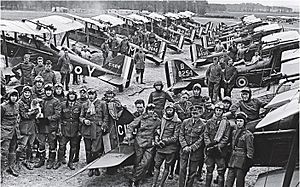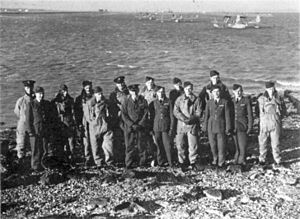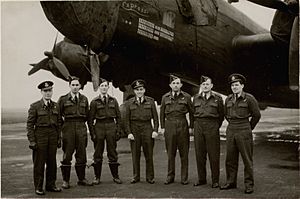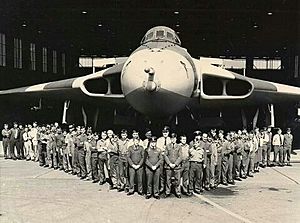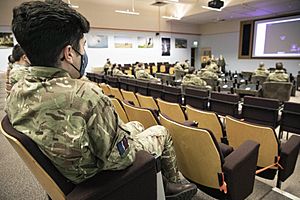Personnel numbers in the Royal Air Force facts for kids
The Royal Air Force (RAF) is the United Kingdom's air and space force. It was created in 1918. This article looks at how many people have worked for the RAF over the years. The number of RAF staff has changed a lot. It goes up when there's a big need, like during wars. After World War II, the numbers slowly went down. The RAF also became smaller, with fewer bases. Sometimes, special plans were made to reduce staff when there were too many people.
Contents
History of RAF Staff Numbers
The Royal Air Force has often changed its staff numbers. This happened to match threats or when threats disappeared. For example, after World War I and World War II, many people left the RAF. Other changes happened during peacetime. These included plans like Options for Change in 1990 and Front Line First in 1994.
After World War I
After the First World War, the RAF became much smaller. Many staff left, and there were fewer aircraft. However, new people still joined. One big change was that the Women's Royal Air Force (WRAF) was completely closed down in 1920.
On Armistice Day in 1918, the new RAF had 291,170 people. The plan was to reduce this to 60,000 by October 1919. By October 1919, the number was actually 58,000. This made some people in the RAF worried. They feared the RAF might lose its independence. They worried it would become part of the Navy or the Army. In 1925, the government decided to pause the RAF's growth. Its numbers then dropped from 33,500 in 1926 to 33,009 in 1927.
Growing for World War II
In May 1935, the RAF began to grow again. This was because Germany was building up its military, especially its air force, the Luftwaffe. The plan was to almost triple the number of aircraft and staff. This meant adding 22,500 more people by March 1937.
After the Cold War
After the Cold War ended, the government reviewed the RAF's size. This review was called Options for Change. It aimed to reduce the RAF to 75,000 people. Before 1990, the RAF had about 88,500 staff.
More cuts happened in 1993. These were not part of the first Options plan. The number of staff did not drop enough naturally. Also, one squadron of Tornado jets was removed. So, the new target for staff numbers became 70,000. In 1995, many people across all parts of the UK military lost their jobs. About 9,000 people were made redundant. Of these, 7,500 were from the Royal Air Force alone.
Role of Reservists
To balance these cuts, the government decided to increase the number of reserve personnel. Reservists are people who train part-time and can be called upon when needed. The number of reservists grew a lot. Between October 2013 and October 2021, the percentage of reservists more than doubled.
Example Personnel Numbers
The table below shows how the number of people in the Royal Air Force has changed over time. You can see big increases during wartime and drops afterwards.
| Date | Numbers | Notes | Ref |
|---|---|---|---|
| November 1918 | 291,170 | Planned to reduce to around 60,000 by late 1919 | |
| April 1919 | 149,196 | Included officers, other ranks, and WRAF members | |
| October 1919 | 58,000 | ||
| January 1920 | 26,682 | After many people left, the RAF was one-tenth of its size at the end of World War I | |
| 1927 | 33,009 | Down from 35,300 in 1926 | |
| 1929 | 28,638 | Included officers and other ranks | |
| January 1934 | 30,381 | Included officers, other ranks, apprentices, and cadets | |
| May 1936 | 32,456 | Increased during the period of expansion | |
| September 1939 | 175,392 | About 118,000 were estimated to be in all operational areas outside India | |
| April 1944 | 1,185,913 | Included officers, other ranks, and WRAF members | |
| May 1945 | 1,079,835 | ||
| 1952 | 270,000 | ||
| April 1958 | 210,000 | A cut of 20,000 people from April 1957 | |
| 1960 | 163,800 | Also included 73,000 civilians | |
| 1962 | 148,000 | ||
| 1970 | 108,800 | Also included 15,400 civilians | |
| 1976 | 96,300 | ||
| September 1978 | 84,792 | ||
| September 1979 | 87,392 | ||
| 1981 | 91,965 | ||
| September 1982 | 89,254 | ||
| April 1989 | 93,100 | Included officers, other ranks, and WRAF members | |
| July 1990 | 89,000 | ||
| 1993 | 70,000 | ||
| April 1997 | 57,000 | Planned to reduce to 56,000 by 1999 | |
| 2000 | 52,000 | ||
| December 2004 | 48,900 | Defence cuts aimed to reduce numbers to 41,000 by 2008 | |
| January 2018 | 36,960 | ||
| January 2021 | 32,920 | ||
| April 2022 | 33,320 | These numbers do not include reservist personnel. The UK Government expects the RAF to have 31,750 people. |


